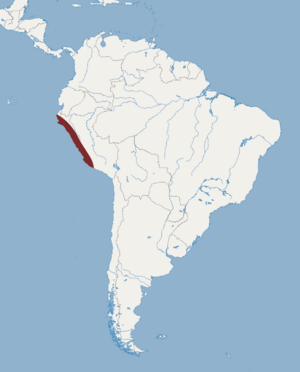Blunt-eared bat facts for kids
Quick facts for kids Blunt-eared bat |
|
|---|---|
| Conservation status | |
| Scientific classification | |
| Genus: |
Tomopeas
|
| Species: |
ravus
|
 |
|
The blunt-eared bat or Peruvian crevice-dwelling bat (Tomopeas ravus) is a special type of bat found only in Peru. It's the only member of its genus called Tomopeas and a group of bats known as Tomopeatinae. This small bat is considered critically endangered, mainly because its home is disappearing.
Contents
Understanding the Blunt-Eared Bat
Why is its Classification Confusing?
When the blunt-eared bat was first discovered in 1900 by Gerrit Smith Miller Jr., scientists weren't sure where it fit in the bat family tree. They first thought it belonged to the Vespertilionidae family, also known as "vesper bats."
Later, in 1970, some experts suggested it should have its own family because it had features from both vesper bats and another family called Molossidae (free-tailed bats). It wasn't until 1994, when scientists studied its DNA, that they realized it was actually closer to the free-tailed bats.
Today, most scientists agree that the blunt-eared bat is the only member of a special group called Tomopeatinae, which is part of the Molossidae family. It's even thought to be a very early branch of all free-tailed bats.
What Do Its Names Mean?
The genus name Tomopeas might come from the Malay word "mops," which means "bat." The scientist Miller used "mops" in other bat names he described. The second part of its scientific name, Ravus, is a Latin word meaning "tawny," which describes its yellowish-brown fur color.
Appearance of the Blunt-Eared Bat
What Does This Bat Look Like?
The blunt-eared bat has soft, thick fur that is a pale yellowish-gray on its back. Its belly fur is lighter, a creamy color. Its wings, face, and ears are dark. Each hair on its body is about 8 millimeters (0.3 inches) long.
Like other free-tailed bats, it has a flat tragus (a small flap in the ear) and a small, clear antitragus (another ear flap). Its nostrils are shaped like tubes.
How Big is the Blunt-Eared Bat?
These bats are incredibly tiny! They weigh only about 2 to 3.5 grams (0.07 to 0.12 ounces), which is less than a few paper clips. From its nose to its tail, it measures about 73 to 85 millimeters (2.9 to 3.3 inches) long. Its forearms are about 31.2 to 34.5 millimeters (1.2 to 1.4 inches) long. Both male and female bats are about the same size.
One unique thing about this bat is its tail. While most free-tailed bats have a long tail sticking out from their wing membrane, the blunt-eared bat's tail only sticks out a very short distance, about 5 to 6 millimeters (0.2 inches).
Life and Habits of the Blunt-Eared Bat
What Do We Know About Its Life?
Since these bats are quite rare, scientists don't know a lot about their daily lives. However, young bats and mothers feeding their babies have been seen in July and August. This suggests that these months are an important time for them to have their young.
What Do They Eat?
The blunt-eared bat is an insectivore, meaning it eats insects.
Any Health Issues?
These bats have been found to carry a tiny protozoan parasite called Eimeria. In fact, a new type of Eimeria was discovered in the blunt-eared bat and was named Eimeria tomopea after it.
Where the Blunt-Eared Bat Lives
Its Home in Peru
The blunt-eared bat lives only in Peru. It prefers the dry and semi-dry areas along Peru's coast. These bats can be found from sea level up to about 2,300 meters (7,500 feet) high in the mountains.
During the day, they rest in small cracks and crevices found in granite rocks and rocky areas. The cracks they use are very narrow, only about 0.5 to 1 inch (1.3 to 2.5 centimeters) wide. They might even prefer cracks that face west or southwest.
In 2010, a blunt-eared bat was found about 230 kilometers (140 miles) south of where it was previously thought to live. This was exciting because it was the first time anyone had seen this bat in over thirty years! Some studies in 2013 suggested that their home range might even stretch into southwest Ecuador, but there's no proof of that yet.
Protecting the Blunt-Eared Bat
Why is This Bat Endangered?
The blunt-eared bat has only been found in twelve specific places, and four of these spots are very close to each other. The total area where they live is estimated to be less than 100 square kilometers (39 square miles).
In Peru, this bat is considered critically endangered, meaning it's at a very high risk of disappearing forever. The International Union for Conservation of Nature (IUCN) first listed it as "vulnerable" in 1996 and 2008, but then changed its status to "endangered" in 2016.
The biggest threat to the blunt-eared bat is the loss of its habitat. Its natural home is being destroyed to make way for farms and growing cities. Also, efforts to control vampire bats sometimes involve fumigating entire caves, which can accidentally kill all the bats inside, including blunt-eared bats.
However, some scientists in 2013 caught two blunt-eared bats without much effort. This made them wonder if the bat is truly rare, or if scientists just haven't been looking for it in the right ways. More research is needed to understand this amazing bat better and help protect it.
See also
 In Spanish: Tomopeas ravus para niños
In Spanish: Tomopeas ravus para niños


